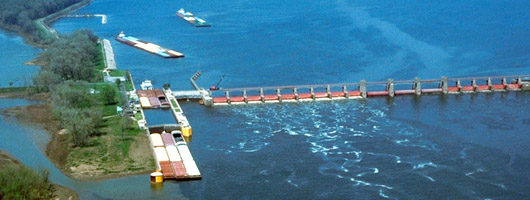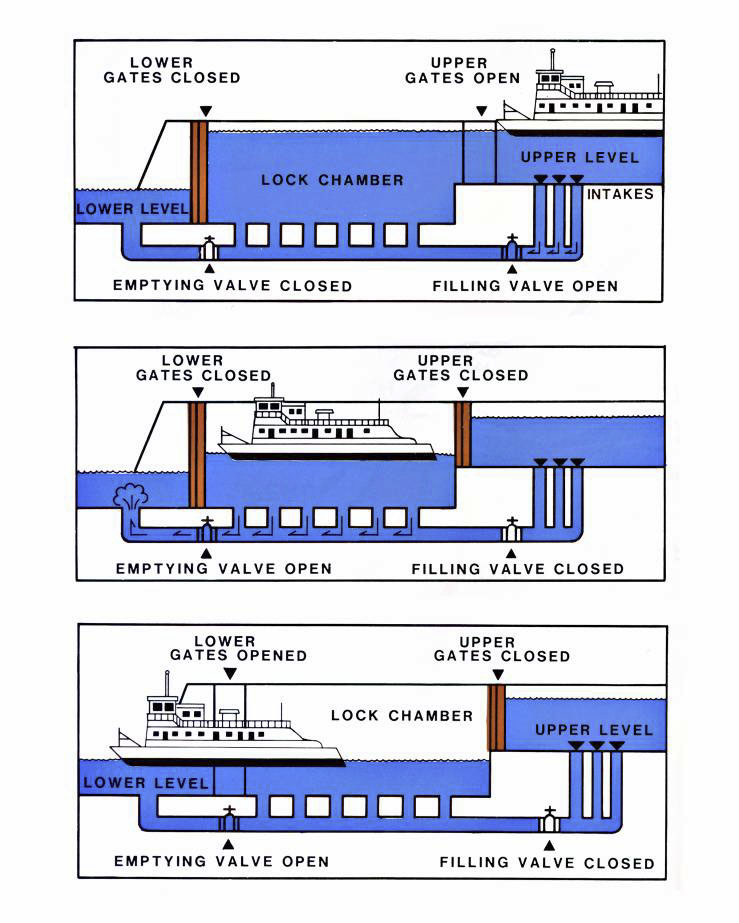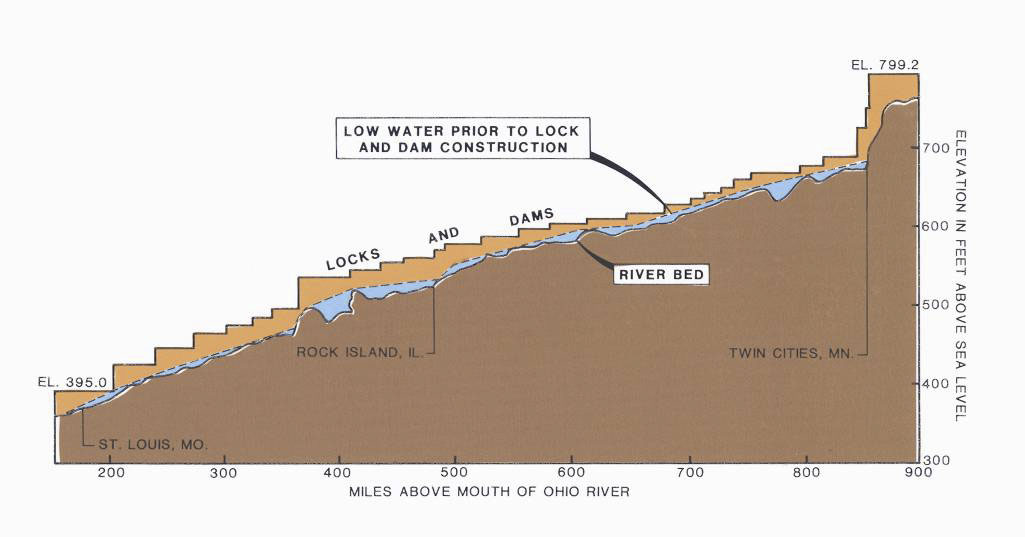
Lock & Dam 25
Operational on May 18, 1939 and located in Winfield Missouri, Lock and Dam 25 is the third southern-most dam in the system on the Upper Mississippi River.
The dam, which is 1,296 feet long, consists of 14 tainter gates and 3 roller gates. The tainter gates pivot vertically and are raised or lowered to control the depth of the water in the pool upstream of the dam. In times of high water, these gates are raised completely and the river flows almost unimpeded, allowing a more natural flow of the river. The roller gates, located near the center of the dam, also restrict the water flow, but in a manner meant to reduce erosion.
Vital Statistics
| Location: | Winfield, Mo. |
|---|---|
| Mississippi River Mile: | 241.4 |
| 1st Day of Operation: | May 18, 1939 |
| Average lift: | 15 feet |
| Pool size: | 49,674 Acre Feet |
| Pool length: | 27.8 miles |
| Lock characteristics: |
Single Lock, 600 feet long, 110 feet wide |
| Dam Characteristics: |
1,296 feet long, 14 Tainter Gates, 3 Roller Gates |
| Phone number: | (636) 566-8120 |
| Marine Radio: | 12 |
Nine-Foot Navigation Channel
Located in Winfield, Missouri, Lock and Dam 25 is part of the Upper Mississippi River Nine Foot Navigation Project. The Project, authorized by the Rivers and Harbors Act of 1930, created and ensured a nine-foot deep navigation river channel.
On the Upper Mississippi, a total of 29 lock and dam systems were constructed, forming a stairway of water from Minnesota to Illinois. From the first lock and dam at Minneapolis-St. Paul, Minnesota to the last one at Granite City, Illinois, there is a drop in elevation of 420 feet. The locks are necessary at each of the dams to allow boats to navigate from one pool (the water backed up behind each dam) to the next. These dams were constructed to aid only navigation; they were not designed for flood control.
On the Lower Mississippi, the river does not need locks and dams because, with the addition of the Missouri, Illinois, Arkansas, Ohio, and other rivers, it is naturally wide enough and deep enough for navigation.
Locking Process
The lock chamber consists of four miter gates (two at each end of the chamber), and four valves (two at each end). All boats wishing to pass through a dam must lock through the lock chamber, even during open river conditions.
Lockage is completed by using a system of valves to raise and lower the water level in the lock chamber. This is an elevator system for boats; raising or lowering the water adjusts the boats to the necessary pool level.
There are two sets of valves on the lock. The filling valves, located near the upper gate, are opened to allow water to enter the chamber, making it the same height as the upper pool. The emptying valves, located near the lower gate, are opened to allow water to drain out, making the chamber the same height as the lower pool. During the process, no pumps are used; the water is moved solely by gravity.
On the Upper Mississippi River, a full tow consists of a towboat and 15 barges, arranged 3 wide by 5 long. A full tow is around 1200 feet long, so at Lock 25 a double lockage must be performed. The first three rows of the tow’s barges would be untied and locked through separately, using a tow haulage (cable and hoist system). Then, the remaining barges and the towboat would lock through and afterwards the barges would all be ratcheted back together. This process typically occupies up to two hours, which is why the U.S. Army Corps of Engineers is considering the addition of a 1200 foot lock chamber that would eliminate the need for a double lockage.

Annual Tonnage
| Year | Tonnage | Lockages |
|---|---|---|
2009 |
26,926,504 |
4,545 |
2008 |
23,244,934 |
3,929 |
2007 |
30,204,744 |
5,314 |
2006 |
31,026,288 |
4,971 |
2005 |
29,043,655 |
4,886 |
2004 |
27,894,562 |
4,795 |
2003 |
33,749,527 |
5,614 |
2002 |
38,916,145 |
6,601 |
2001 |
34,858,294 |
6,008 |
2000 |
39,177,450 |
6,623 |
1999 |
39,536,830 |
6,777 |
1998 |
34,819,845 |
6,110 |
1997 |
33,638,634 |
6,132 |
1996 |
36,088,709 |
6,652 |
1995 |
37,432,909 |
6,654 |
1994 |
30,758,651 |
5,658 |
1993 |
26,560,658 |
4,687 |
1992 |
39,378,151 |
7,282 |
1991 |
37,758,657 |
7,394 |
1990 |
42,339,143 |
7,923 |
1989 |
36,218,686 |
7,118 |
1988 |
37,875,033 |
7,326 |
1987 |
35,319,224 |
6,720 |
1986 |
28,159,960 |
5,681 |
1985 |
26,109,104 |
5,389 |
1984 |
36,167,255 |
7,027 |
1983 |
37,439,016 |
7,319 |
1982 |
32,767,055 | 6,586 |
| 1981 | 34,309,187 | 7,067 |
| 1980 | 32,519,470 | 6,770 |
| 1979 | 28,638,386 | Na |
| 1978 | 29,041,957 | 6,100 |
| 1977 | 25,093,200 | 5,671 |
| 1976 | 24,781,578 | 5,708 |
| 1975 | 23,712,446 | 5,336 |
| 1974 | 24,292,547 | 5,374 |
| 1973 | 22,706,350 | 5,085 |
| 1972 | 24,611,927 | 5,785 |
| 1971 | 21,430,888 | 5,580 |
| 1970 | 22,175,609 | 5,327 |
| 1969 | 18,622,522 | 4,715 |
| 1968 | 16,547,642 | 5,146 |
| 1967 | 16,355,932 | 4,906 |
| 1966 | 15,857,490 | 4,803 |
| 1965 | 13,425,723 | 4,287 |
| 1964 | 13,408,798 | 4,664 |
| 1963 | 12,599,623 | 4,345 |
| 1962 | 10,814,046 | 4,023 |
| 1961 | 9,762,001 | 3,866 |
| 1960 | 9,686,116 | 3,737 |
| 1959 | 9,154,872 | 3,834 |
| 1958 | 8,464,618 | 3,646 |
| 1957 | 7,460,929 | 3,383 |
| 1956 | 6,792,648 | 2,884 |
| 1955 | 6,530,038 | 2,974 |
| 1954 | 5,675,246 | 2,914 |
| 1953 | 5,072,640 | 2,870 |
| 1952 | 4,044,774 | 2,276 |
| 1951 | 4,225,148 | 2,187 |
| 1950 | 4,323,837 | 2,571 |
| 1949 | 3,654,954 | 2,634 |
| 1948 | 3,252,308 | 2,341 |
| 1947 | 3,120,342 | 2,068 |
| 1946 | 2,989,198 | 2,570 |
| 1945 | 2,033,557 | 1,695 |
| 1944 | 1,875,881 | 1,624 |
| 1943 | 1,608,788 | 1,687 |
| 1942 | 1,987,289 | 2,447 |
| 1941 | 1,974,121 | 2,189 |
| 1940 | 1,570,167 | 2,188 |
| 1939 | 1,122,824 | 1,645 |

